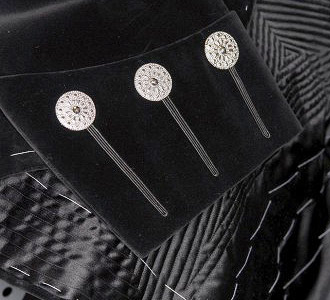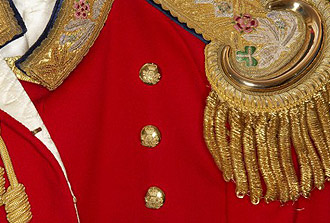1804: Having inherited the business from his brother, Thomas Davies opens Davies & Son on Hanover Street in Mayfair and goes on to boast that the firm dresses ‘all the crowned heads of Europe’.
1805: James Gieve (founding father of Gieves & Hawkes) is employed by ‘Old Mel’ Meredith, the Portsmouth-based tailor by appointment to the Royal Navy. Meredith tailors the uniform Admiral Lord Nelson is wearing when killed in action aboard HMS Victory defeating the combined French and Spanish fleets at the Battle of Trafalgar. Nelson goes to his death wearing a cocked hat designed by James Lock & Co with a green silk eyeshade to cover his blinded right eye. One of Nelson’s last acts before embarking on his last voyage aboard HMS Victory was to settle his bill at James Lock & Co.
1806: James Poole, the founding father of Henry Poole & Co, and his wife Mary make a great success of tailoring for the officers’ troops at the Battle of Waterloo. No tailors are recorded on Savile Row at this time although contemporary firms Davies & Son, Adeney & Boutroy, John Levick, Stultz, Meyer, Burghart and Davidson were colonising various streets surrounding the Row including Clifford Street, Cork Street, Conduit Street, Sackville Street and Hanover Street.
1808: Beau Brummell is at the height of his fame as a man of fashion and sartorial advisor to The Prince Regent (later King George IV). His preferred tailors, military specialists both, are Schweitzer on Cork Street and Meyer on Conduit Street. It is Brummell who introduces the trouser (a variation on riding breeches) to fashionable London. The minimalist, masculine elegance of the dandy espoused by Brummell is a riposte to the excesses that fanned the flames of the French Revolution, replacing gaudy embroidered silk court costume with plain black or navy wool tailcoats and buff breeches, lace jabots with fine linen cravats and buckled satin court shoes with dashing riding boots. London flocks to Brummel’s Chesterfield Street townhouse to watch him bathe and dress as he introduces the concept of daily ablutions and no perfume but the scent of freshly laundered linen into polite society. Brummell is the godfather of Savile Row’s elegant, understated aesthetic.
1818: Burlington Arcade, a glassed-over esplanade of shops adjacent to Burlington House, is constructed under the patronage of Lord George Cavendish who resides at No 1 Savile Row (now Gieves & Hawkes), where Brummell was a guest before his fall from Royal favour and spiralling debts forced him to seek exile in France in 1816.
1821: Joseph Ede, who would eventually give his name to Ede & Ravenscroft, assists guv’nor William Webb as Royal robe maker when The Prince Regent ‘Prinny’ is finally crowned King George IV in particularly overwrought pomp and circumstance after enduring years of deputising for his ‘mad’ father King George III. Walter Grant Norton opens his tailor’s shop on the Strand. Norton & Sons would relocate to Lombard Street in the City and carve a niche for itself as the definitive City tailor before finally relocating to the Row where the firm remains today.
1846: James Poole’s son Henry inherits the firm from his late father and earns his title of ‘Founder of Savile Row’ when he turns the Savile Row-side workshops of his father’s tailoring shop at No 4 Old Burlington Street into a grand, Palladian entrance to a bespoke tailoring business called Henry Poole & Company at No 32 Savile Row.
1849: Henry Huntsman establishes his tailoring firm H. Huntsman & Sons specialising in riding breeches and sporting clothes. Queen Victoria and Prince Albert become customers as do the majority of European Royal houses.
1850: James Lock & Co invents a Savile Row icon: the bowler hat. The bowler was commissioned by William Coke (a relative of the current Earl of Leicester) to be worn by his gamekeepers as protection against falling pheasants and poachers’ sticks. The bowler is still called a Coke at Lock & Co.
1852: James Gieve acquires a partnership with the tailoring house Joseph Galt (established in 1823 and incorporating Meredith) and christens the new firm Galt & Gieves. His equally ambitious sister Elizabeth independently holds Queen Victoria’s Royal Warrant as Dressmaker and Milliner (an honour she holds until her retirement in 1889, a year after James’s death).
1858: Henry Poole earns the first of his Royal Warrants from the newly crowned Emperor Napoleon III of France, to whom Poole and Baron de Rothschild advanced £10,000 to stage a coup in France to establish The Second Empire. At the accession of Emperor Napoleon and his Empress Josephine, Henry Poole erects an audacious gas illuminated eagle-and-coronet light show above the facade of No 36, an act he takes to repeating on all great Royal occasions connected to his customers.
1860: Bertie, the rakish Prince of Wales, orders a short smoking jacket to wear at informal dinner parties at Sandringham from his friend Henry Poole. It is the first dinner jacket on record and was cut in midnight blue cloth. In 1886, a Mr James Potter of Tuxedo Park, New York, is a house-guest at Sandringham. He consequently orders a similar dinner jacket to Bertie’s from Henry Poole & Co. It is this DJ that Mr Potter wears at the Tuxedo Park Club inspiring numerous copies that fellow members wear as informal uniform for stag dinners. Thus the Tuxedo was born at Henry Poole & Co.
1862: Emperor Wilhelm I of Prussia confers his Royal Warrant on Norton & Sons. He is introduced to the house when visiting London as a guest at the wedding of Louis IV, Grand Duke of Hesse and Queen Victoria’s daughter Princess Alice (mother of the ill-fated last Tsarina of Russia).
1865: German immigrant Jacob Dege opens his first tailor’s shop at No 13 Conduit Street. He is the founding father of the tailoring dynasty we now know as Dege & Skinner.
1866: While searching for the source of the Nile, explorer Dr. David Livingstone is rescued by journalist H.M.Stanley. Stanley is dressed by Henry Poole & Co and Dr. Livingstone by Gieves.
1871: Joseph Webb Ede marries Rosanna Ravenscroft, scion of the wig-making dynasty founded in 1726. Six months later, Joseph dies leaving ‘Rosa’ Ede in the director’s chair where she would remain for 60 years. The matriarch holds Queen Victoria’s Royal Warrant. Embroiderer M. Hand moves to Lexington Street, Soho premises to be closer to its customers on Savile Row. A hive of organised industry, cords are woven in the basement, laces on a loom on the ground floor and embroidery on the upper floors.
1875: Angelical Patience Fraser, ‘the tailors’ Florence Nightingale’, begins religious readings in the tailoring sweatshops of Soho and later holds a tailors-against-drink rally in response to the notorious ‘Carnaby Boy’ clique of drunkard tailors who terrorise the area.
1876: Henry Poole dies having penned a sadly prophetic note declaring, ‘There will be nothing much to leave behind me.’ Vanity Fair mourns his passing with a fond eulogy that records ‘So Old Pooley is dead’. He has acquired 16 Royal Warrants but the Savile Row tradition of extending unlimited credit to its regal customers leaves the firm in penury. Henry’s sister Mary Ann and his first cousin Samuel Cundey retrench and save Henry Poole from extinction. Thus the Cundey dynasty takes control of Henry Poole & Co.
1880: Jacob Dege’s son Arthur meets William Skinner at Merchant Taylors’ School, Charterhouse Square in the City of London. The friends open Arthur Dege & Skinner but on the death of Arthur’s older brothers, he returns to work for the family firm of J Dege & Sons and the name Dege & Skinner would not reappear above a West End tailor’s shop for another 90 years.
1882: The house we know today as Kilgour opens its doors.
1892: Miss Fanny Hicks is forced to tell the Trade Union Congress in Glasgow that trousers made for Queen Victoria’s grandson the Duke of York (later King George V) were made in a Soho sweatshop where typhoid fever has broken out. Miss Hicks then discloses that Davies & Son (the Duke’s tailor) is a subcontractor of the sweatshop. The scandal of the Duke of York’s Trousers is recorded in The Pall Mall Gazette and compounded by the mysterious death of the Duke’s brother and heir apparent Prince Albert Victor in January 1892.
1895: James Lock & Co delivers a hat to the playwright Oscar Wilde at the St James’s Theatre where his The Importance of Being Earnest is the toast of London. The bill remains unpaid when Wilde is arrested at the behest of his lover Lord Alfred ‘Bosie’ Douglas’s father the Marquis of Queensbury. The bill remains unpaid until 2000, the centenary of Wilde’s death, when a cheque is posted at No 6 St James’s Street discharging Wilde’s debt to the hatter. John Lobb, founder of the famed bespoke shoemaker, dies and in 1901 his son William Lobb moves the business to St James’s Street where it finally settles at No 9, formerly the bachelor quarters of ‘mad, bad and dangerous to know’ poet Lord Byron.




